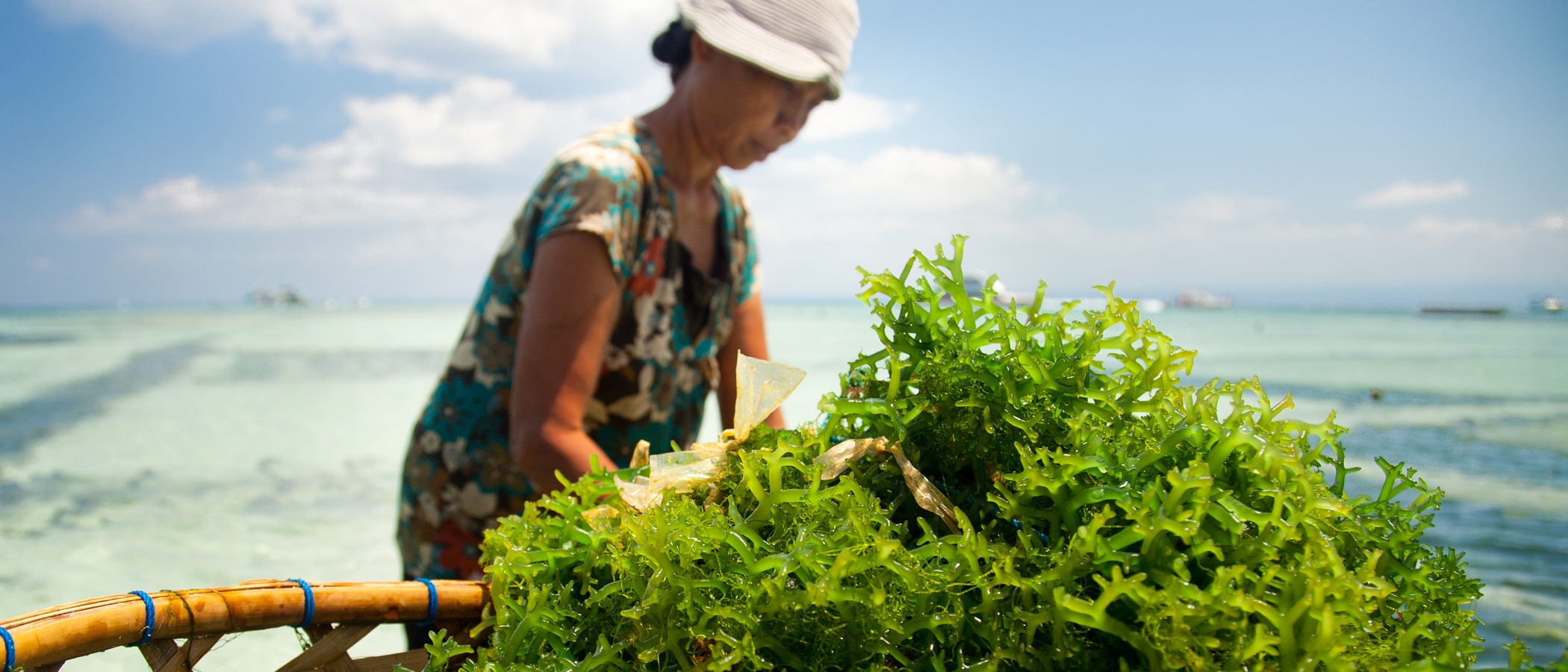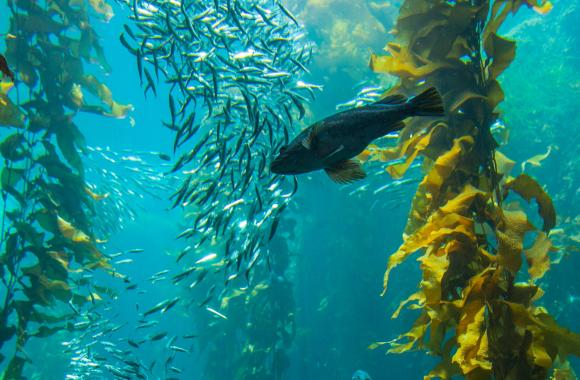Seaweed Farming
Seaweed farming is one of the most sustainable types of aquaculture. Expanding seaweed farming enhances carbon sequestration and boosts production of biomass that can be used for biofuel, bioplastic, livestock feed, and human consumption.
Reduced/Sequestered
2020–2050
To Implement
Operational Savings
Impact
Seaweed farms occupied only 0.19 million hectares in 2018. Expanding sustainable seaweed farming to 13.39–25.14 million hectares by 2050 could sequester an additional 2.50–4.72 gigatons of carbon dioxide and create additional feedstock for other solutions at a net lifetime cost of US$4.97–9.40 trillion for 2020–2050.
Introduction
Macroalgae are fast-growing marine plants that absorb high amounts of carbon dioxide. They are among the most productive organisms on Earth. Recent findings have quantified the long-term carbon sequestration potential of macroalgae at 0.17 gigatons of carbon per year, exceeding the carbon buried in coastal environments such as mangroves, saltmarshes, and seagrass beds.
Project Drawdown defines its Seaweed Farming solution as the culturing and cultivation of macroalgae in the ocean for long-term carbon sequestration in the form of excess unharvested biomass that is exported to the deep sea and/or ocean shelves and buried in ocean sediments. We assume this solution will be deployed in ocean areas that do not have alternative uses.
Macroalgae aquaculture comprises 27 percent of total marine aquaculture production and is valued at 5 percent of the total value of aquaculture crops. In 2005, global farmed macroalgae production was estimated at 13.5 million metric tons. By 2016, global yields more than doubled, reaching 31.2 million metric tons. The sharp increase in macroalgae farming between 2005 and 2016 is likely to continue with the leading producing nations focusing on ensuring the sector’s long-term sustainability.
Methodology
Total Ocean Area
Out of a total ocean area available for the solution of 240 million hectares, the solution adoption in 2018 was 0.19 million hectares (0.08 percent). The total ocean area available for this solution was modeled using the 5 percent of global area suitable for macroalgae growth considering nutrients and temperature constraints. Globally, nearly 4.8 billion hectares are suitable for macroalgae growth based on Froehlich et al. (2019). However, we considered only 5 percent of this as the total ocean area for this solution to keep our estimates conservative.
Adoption Scenarios
We developed 10 custom adoption scenarios based on a variety of assumptions regarding different rates of macroalgae biomass production from FAO for 2006–2016, projected growth rates of macroalgae farming by 2050 from the World Bank, and projected growth from a report by Hoegh-Gudlberg et al. (2019).
We calculated impacts of increased adoption of Seaweed Farming from 2020 to 2050 by comparing two growth scenarios with a reference scenario in which the market share was fixed at current levels.
-
Scenario 1: The solution is adopted on 13.39 million hectares (6 percent of the total available ocean area).
-
Scenario 2: The solution is adopted on 25.14 million hectares (10 percent of the total available ocean area).
Achieving 100 percent adoption is not likely due to the technological and economic constraints.
Sequestration
The seaweed farming sequestration rate, based on a formula multiplying seaweed yield, percent of farmed biomass exported, carbon content of algae biomass, and percent of long-term carbon sequestration, was 3.21 metric tons of carbon per hectare per year. We based the yield estimate on 44 data points from 16 sources, the farmed biomass export on two data points from two sources, the carbon content of algae biomass on 30 data points from 16 sources, and the percent of long-term carbon sequestration on two data points from two sources.
Financial Model
All costs are given in 2014 US$.
We assumed that the landowner or manager bears any costs for seaweed farming. Financial inputs are calculated only for the solution (not for conventional practice) given that this solution is deployed only in areas that are not allocated for other purposes. First costs amount US$9,705 per hectare per year based on 13 data points from three sources. Operating costs amount to US$ 11,585 per hectare per year, based on 14 data points from four sources. Net profit margin was US$12,892 per hectare per year, based on 12 data points from two sources.
Integration
The Seaweed Farming solution was not affected by integration with other solutions because this solution is assumed to be developed in ocean areas that do not have alternative uses.
Results
Scenario 1 reduces greenhouse gas emissions by 2.50 gigatons of carbon dioxide equivalent by 2050. The net first cost to implement is US$132.14 billion, and the lifetime net operational cost is US$4.97 trillion.
Scenario 2 reduces greenhouse gas emissions by 4.72 gigatons of carbon dioxide equivalent by 2050. The net first cost to implement is US$249.80 billion, and the lifetime net operational cost is US$9.40 trillion.
Discussion
Research on the mitigation potential resulting from scaling up seaweed farming is limited. Hoegh-Guldberg et al. (2019) projected an “associated sequestration of nonseen production” of 0.0013 to 0.0027 gigatons of carbon dioxide equivalent per year by 2030 and 0.0067 to 0.044 gigatons of carbon dioxide equivalent per year by 2050. These values are considerably lower than ours, which are 0.06–0.11 gigatons of carbon dioxide equivalent per year by 2030 and 0.15–0.29 gigatons of carbon dioxide equivalent per year by 2050. However, Hoegh-Guldberg et al. (2019) used lower estimates for yield that are based only on one source, while we based our yield estimate on 24 data points from 16 sources and lower adoption cases. More recent work (e.g,, Gallagher et al., 2022) also underscores the degree of uncertainty around the extent to which seaweed can mitigate climate change.
Economic data are limited and costs are highly variable. Therefore, more data on financials would benefit the model in future updates.
Scaling up seaweed farming brings many benefits to other sectors. Seaweed biomass is being used in an increasing number of applications, including animal feed, bioplastics, and biofuel, unlocking potential for market growth and creating opportunities to reduce greenhouse gas emissions from other sectors—for example, by adding seaweed to livestock feed to reduce methane emissions from cattle.
REFERENCES
H. E. Froehlich, J. C. Afflerbach, M. Frazier, B. S. Halpern, Blue Growth Potential to Mitigate Climate Change through Seaweed Offsetting. Current Biology 29, 3087-3093.e3 (2019).
Gallagher, J. B., Shelamoff, V., & Layton, C. (2022). Seaweed ecosystems may not mitigate CO2 emissions. ICES Journal of Marine Science.
Hoegh-Guldberg O. et al. (2019). The Ocean as a Solution to Climate Change: Five Opportunities for Action. World Resources Institute. http://www.oceanpanel.org/climate
What You Can Do
If you use carbon offsets, look into sustainable seaweed as an option.
If you're an investor, consider funding efforts to improve and deploy this climate mitigation technology.
- Expand your knowledge by exploring another Drawdown solution.



